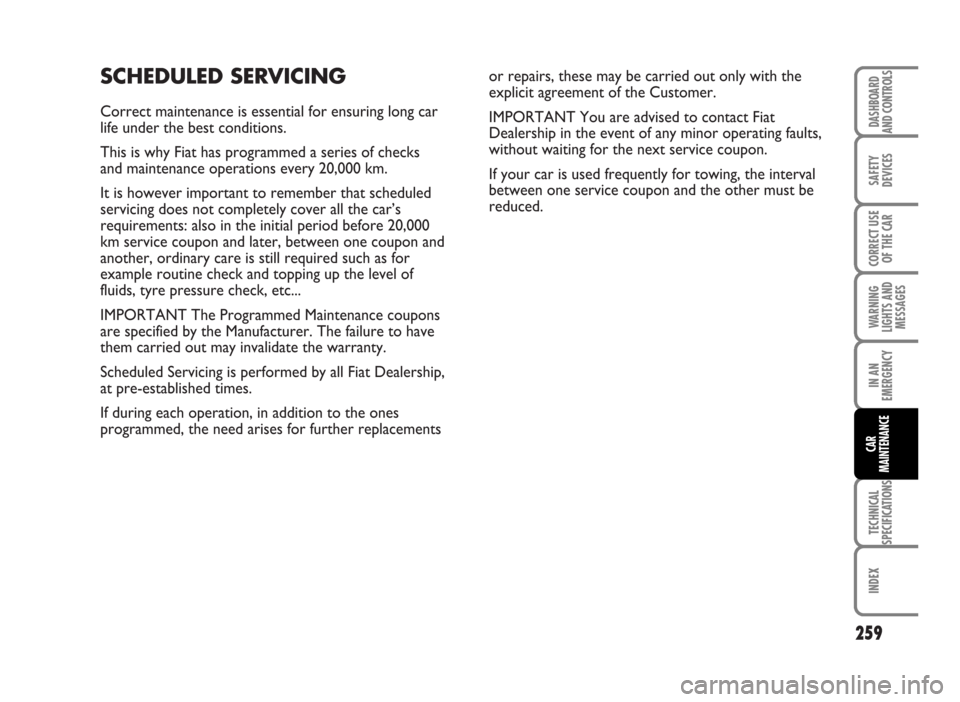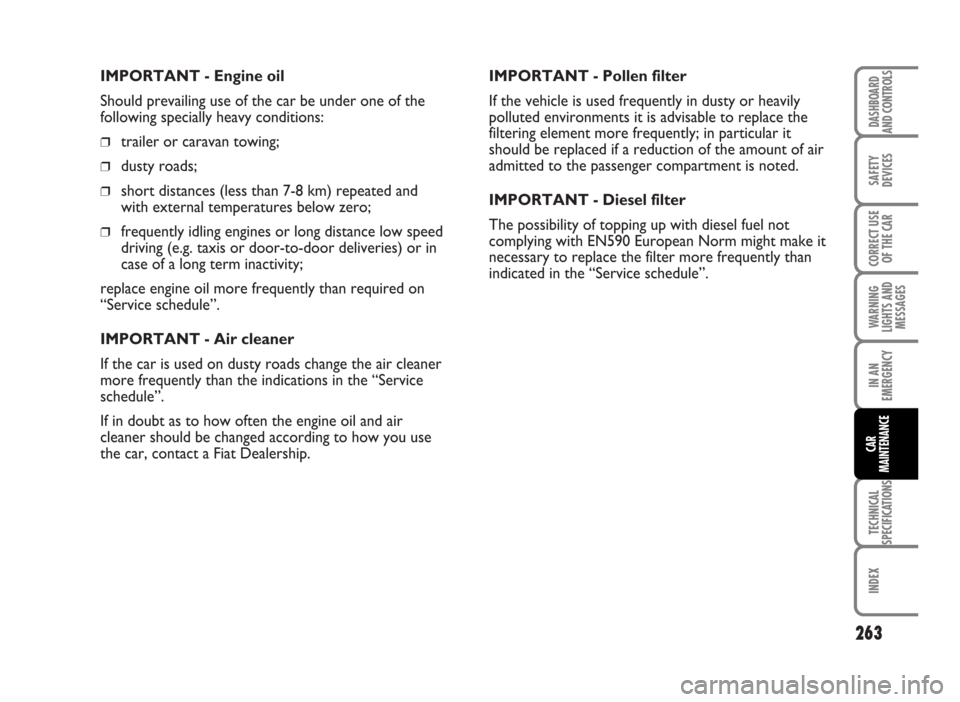Page 258 of 314

257
SAFETY
DEVICES
CORRECT USE
OF THE CAR
WARNING
LIGHTS AND
MESSAGES
CAR
MAINTENANCE
TECHNICAL
SPECIFICATIONS
INDEX
DASHBOARD
AND CONTROLS
IN AN
EMERGENCY
WARNING
WARNING
Do not start the engine when towing the car.
WARNINGWhile the car is being towed with the
engine off, remember that the brake
pedal and steering will require more
effort as you no longer have the benefit
of the brake booster and the electrical
power steering. Do not use flexible cables
to tow. Avoid jerking. Whilst towing,
ensure that the coupling to the car does
not damage the surrounding components.
When towing the car, you must comply
with the specific traffic regulations
regarding the tow hitch and how to tow
on the road. TOW RING HOOKING
Proceed as follows:
❒take the tow ring (B) from its support;
❒tighten the ring on the rear or front threaded pin.
F0H0204m
F0H0205m
Before starting to tow, turn the ignition
key to MAR and then to STOP. Do not
remove the key. If the key is removed, the
steering lock engages automatically which
prevents the wheels being turned.
Page 260 of 314

SCHEDULED SERVICING
Correct maintenance is essential for ensuring long car
life under the best conditions.
This is why Fiat has programmed a series of checks
and maintenance operations every 20,000 km.
It is however important to remember that scheduled
servicing does not completely cover all the car’s
requirements: also in the initial period before 20,000
km service coupon and later, between one coupon and
another, ordinary care is still required such as for
example routine check and topping up the level of
fluids, tyre pressure check, etc...
IMPORTANT The Programmed Maintenance coupons
are specified by the Manufacturer. The failure to have
them carried out may invalidate the warranty.
Scheduled Servicing is performed by all Fiat Dealership,
at pre-established times.
If during each operation, in addition to the ones
programmed, the need arises for further replacementsor repairs, these may be carried out only with the
explicit agreement of the Customer.
IMPORTANT You are advised to contact Fiat
Dealership in the event of any minor operating faults,
without waiting for the next service coupon.
If your car is used frequently for towing, the interval
between one service coupon and the other must be
reduced.
259
SAFETY
DEVICES
CORRECT USE
OF THE CAR
WARNING
LIGHTS AND
MESSAGES
IN AN
EMERGENCY
TECHNICAL
SPECIFICATIONS
INDEX
DASHBOARD
AND CONTROLS
CAR
MAINTENANCE
Page 264 of 314

IMPORTANT - Engine oil
Should prevailing use of the car be under one of the
following specially heavy conditions:
❒trailer or caravan towing;
❒dusty roads;
❒short distances (less than 7-8 km) repeated and
with external temperatures below zero;
❒frequently idling engines or long distance low speed
driving (e.g. taxis or door-to-door deliveries) or in
case of a long term inactivity;
replace engine oil more frequently than required on
“Service schedule”.
IMPORTANT - Air cleaner
If the car is used on dusty roads change the air cleaner
more frequently than the indications in the “Service
schedule”.
If in doubt as to how often the engine oil and air
cleaner should be changed according to how you use
the car, contact a Fiat Dealership.IMPORTANT - Pollen filter
If the vehicle is used frequently in dusty or heavily
polluted environments it is advisable to replace the
filtering element more frequently; in particular it
should be replaced if a reduction of the amount of air
admitted to the passenger compartment is noted.
IMPORTANT - Diesel filter
The possibility of topping up with diesel fuel not
complying with EN590 European Norm might make it
necessary to replace the filter more frequently than
indicated in the “Service schedule”.
263
SAFETY
DEVICES
CORRECT USE
OF THE CAR
WARNING
LIGHTS AND
MESSAGES
IN AN
EMERGENCY
TECHNICAL
SPECIFICATIONS
INDEX
DASHBOARD
AND CONTROLS
CAR
MAINTENANCE
Page 300 of 314

299
SAFETY
DEVICES
CORRECT USE
OF THE CAR
WARNING
LIGHTS AND
MESSAGES
IN AN
EMERGENCY
CAR
MAINTENANCE
INDEX
DASHBOARD
AND CONTROLS
TECHNICAL
SPECIFICATIONS
1.216V
1155
500
940
805
1655
1000
400
75
601.4
8V(◊) - 1.416V
1155
500
940
805
1655
1000
400
75
601.3 Multijet
1200
500
940
805
1700
1000
400
75
60
1.9 Multijet
1275
500
1000
805
1775
1100
500
75
60
WEIGHTS
Weights (kg)
Empty weight
(including all fluids, fuel tank at 90 %
and with no optional):
Payload (*)
including the driver:
Maximum admitted
loads (**)
– front axle:
– rear axle:
– total:
Towable loads:
– trailer with brakes:
– trailer without brakes:
Maximum load on roof:
Maximum load on tow hitch
(trailer with brakes):
(*) If special equipment is fitted (sunroof, tow hitch, etc.) the unladen car weight increases thus reducing the specified payload.
(**) Loads not to be exceeded. The driver is responsible for arranging the loads in the boot an/or on the roof so that they comply with
these limits.
(◊) Engine model provided for certain versions/markets only
Page 309 of 314

308
SAFETY
DEVICES
CORRECT USE
OF THE CAR
WARNING
LIGHTS AND
MESSAGES
IN AN
EMERGENCY
CAR
MAINTENANCE
TECHNICAL
SPECIFICATIONS
DASHBOARD
AND CONTROLS
INDEX
Sunroof......................................... 123
Sun visors ................................... 122
Suspensions ................................. 293
Symbols ........................................ 5
Technical specifications........... 286
Third brake light
– bulb replacement ................ 245
Tools ........................................... 242
Towing the car ........................... 255
Towing trailers ........................... 185
Transmission ............................... 292
Transporting children
safely ........................................... 159
Tyres
– snow tyres ............................. 295
– standard ................................. 295
– correct tyre reading ............ 294
Warning lights and messages 191
Weights ........................................ 299
Wheel
– spare wheel ........................... 294
– changing ................................ 230
Wheel geometry ....................... 294
Windows (cleaning) .................. 284Windscreen washer
– control ................................. 104
– fluid level ................................ 270
Windscreen wiper
– blades .................................... 279
– control .................................. 104
– nozzles .................................. 281
– smart washing ...................... 105
Page 310 of 314

AT THE END OF ITS LIFE-CYCLE
For years now Fiat has been developing its global commitment towards the safeguarding and protection of the Environment through
the continuous improvement of its production processes and the making of increasingly more “eco friendly” products. With a view to
guaranteeing the best possible service to clients in full observance of environmental standards and in response to the obligations imposed
by European Directive 2000/53/EC on end-of-life vehicles, Fiat offers its clients the possibility to hand in their vehicle* at the end of its
life span without additional costs.
The European Directive, in fact, provides for the take-back of the vehicle without the last holder or owner of the same incurring
expenses due to the fact that the market value of the vehicle is zero or negative. In particular, in almost all of the countries of the
European Union, up until 1st January 2007, take-back of the vehicle free of charge only applies to vehicles registered from 1 July 2002
on, while, from 2007 on, take-back will be carried out free of charge, independently of the year of registration, provided that the vehi-
cle still contains all its essential component parts (especially engine and body) and is free from additional waste materials.
Our contracted network of authorised treatment facilities has been carefully selected in order to provide a quality service to our cus-
tomers by de-polluting and recycling “End of Life Vehicles” to approved environmental standards. To find out the location of your
nearest authorised treatment facility, offering free of charge take-back, simply contact one of our dealers or refer to the Fiat web site
or call the toll free number 00800 3428 0000.
*
Passenger transportation vehicles to seat a max. of nine persons, having a total admissible weight of 3.5 t